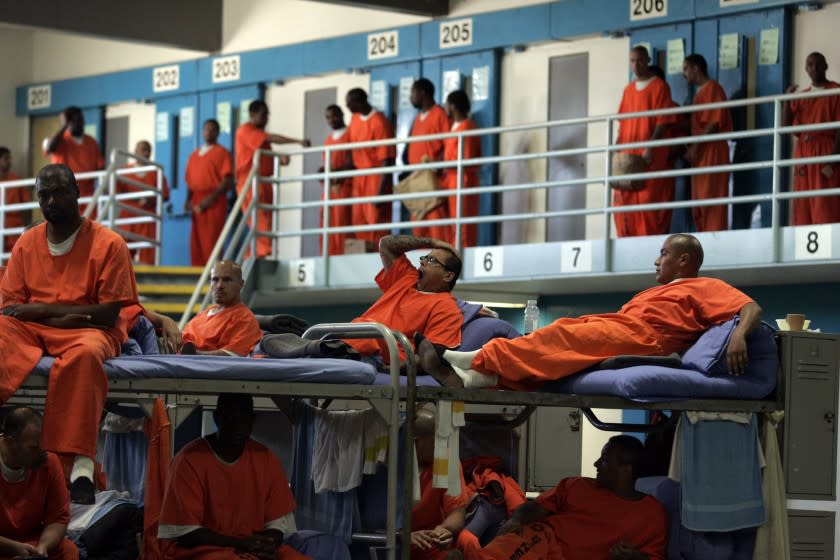Editorial: Coronavirus shows us the danger and inanity of our prison state

Editor’s note: This editorial is the last in a series of three. The first two were published Wednesday and Thursday; you can find them at latimes.com/opinion.
In many U.S. jails and prisons, hygiene costs money. Through work or good behavior, inmates can earn credits at the institution’s canteen and exchange them for packages of soap, shampoo, toothpaste, washcloths and the like. Or families can pay to have those packages delivered to their loved ones, to help them stay relatively healthy during their time behind bars.
But staying healthy while incarcerated is hard, even with purchased personal care products. Contrary to movie images of each inmate locked alone in a cell, many jails and prisons house inmates in barracks-like settings, with beds almost touching, or with bunks doubled or tripled. Inmates live in close contact, eating shoulder to shoulder, sleeping head-to-toe.
Hand sanitizer is generally banned, largely because officials believe inmates will try to intoxicate themselves using the alcohol-based fluid. Soap and water are available, but the brisk business in costly hygiene packets demonstrates serious continuing concerns about sanitation.
Infectious outbreaks in such conditions are the rule — but only now, with the coronavirus pandemic, are Americans witnessing the scope of the hazard we have constructed.
Jails and prisons are the nation’s top danger zones for COVID-19 transmission. Prisons, rather than nursing homes or cruise ships, have vied with one another over the past three months for the largest outbreaks. Chicago’s Cook County Jail was quickly overtaken by Ohio’s Marion Correctional Institution, then the federal Terminal Island prison in Los Angeles.
Many prisons have sharply reduced their populations to allow inmates to practice a modicum of social distancing. The releases have led police and prosecutors to warn that having so many accused or convicted criminals on the street puts the public in danger. Yet during the pandemic, crime has held steady, or in some cases dropped.
So it’s time to ask: Why did we build and pack prisons in the first place? Why did we create institutions that are inherently unsafe and unsanitary? What kind of society clusters people together and then charges them money for hygiene?
Jails and prisons concentrate society’s ills. They have become centers of addiction, mental health breakdown, rape and gang recruitment. One judge labeled California’s prisons as “criminogenic” — fostering rather than slowing criminality. They harden rather than rehabilitate inmates. And they further endanger rather than protect the rest of us, because instead of coming home with new attitudes and new skills, former inmates too often return to their families and neighborhoods broken and likely to continue criminal patterns and behaviors.
And of course released inmates may return to their homes infected with serious disease.
Surely we can do better. No nation on the planet locks up so great a proportion of its people or gets so little benefit — and so much damage — from its efforts.
Slowly, states and the federal government have rolled back laws and policies that have filled jails and prisons. Excessively harsh sentences, adopted and imposed during moments of societal panic over drugs and amid fear-mongering reports over a supposed wave of young predators, are being revisited. Many states, including California, have redefined more nonviolent felonies as misdemeanors. Even before the pandemic, jail and prison populations were dropping in many states.
We can go further. California Gov. Gavin Newsom has proposed closing two of its 35 state prisons. It’s a step in the right direction, in this state and around the nation.
The Los Angeles County jail has reduced its population from about 17,000 to less than 12,000, where it finally is near its rated capacity. In this case, at least, the coronavirus has done what lawsuits, county officials and activist pressure could not — rid the jail of unconscionable overcrowding. It now falls to the sheriff and the supervisors to ensure that the number never again creeps back up.
To do that, they will have to double down on the Alternatives of Incarceration project they adopted in principle earlier this year. Building an infrastructure of community-based mental health, drug treatment, peer counseling and skills training programs will improve public safety and health, so this is no time to plead poverty or de-prioritize the project. It's time to push forward, swiftly and with a new sense of purpose.
Pandemic aside, there should be fewer prisons, less of our treasury devoted to incarceration, and less reliance on locking up people for long terms. Prisons may always be needed, but a free society should envision a system that houses hundreds of people, rather than thousands or tens of thousands. Crime should have consequences, but those consequences should not gratuitously strip offenders of their liberty for decades on end. A society that considers itself free and enlightened surely can find a way to deal with public safety problems and mental health crises in an efficient way that leans less on incarceration and more on rehabilitation.

